Så ställer du in din Saito..!
Engelsk text...!

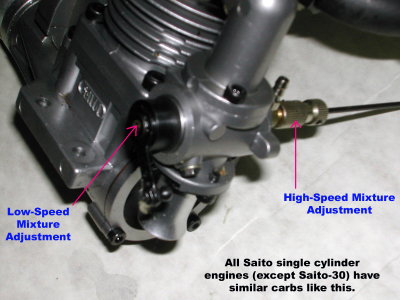
Make sure you know where the carb adjustments are for the high-speed and low-speed mixture settings. All engines except the Saito-30 have the similar carb type.
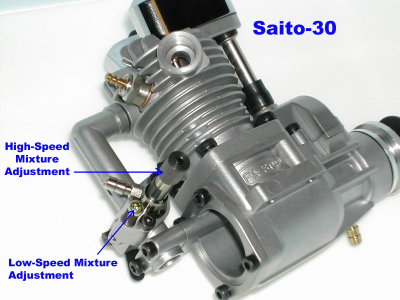
High-Speed Mixture Adjustment: For all engines, the mixture becomes leaner when you turn adjustment inward (clockwise)
Low-Speed Mixture Adjustment: (a) For Saito-30 with air-bleed carb, turning screw inward (clockwise) closes the air-hole and makes the mixture richer.
(b) For all other engines turning adjustment screw inward (clockwise) make the mixture leaner.
CARB ADJUSTMENTS
It is assumed here that if you have a new engine you have already run it at low rpm (4000 maximum) at the rich setting as explained in the instruction manual; this rich low-rpm setting should be used for 15-20 minutes. The final carb mixture settings can then be done as explained below, however 40 - 50 minutes subsequent run time (after the intial 15-20 minutes on a new engine) will probably be necessary to get a final setting with a low idle rpm..
INITIAL SETTING FOR A NEW ENGINE OR ONE THAT IS OUT OF ADJUSTMENT:
(a)High-speed mixture: Set the main high-speed mixture needle valve to the value recommended in the instructions. If you have no instruction manual about 4 turns out will be OK; this is quite a rich setting and the particular value won’t affect the ability of the engine to start because it is the low-speed mixture setting that affects the starting.
(b) Low-Speed Mixture: The low-speed needle should already be set about right (ie somewhat rich) for new engines as they come out of the box. If unsure about the initial setting adjust the needle so that the top is flush with the throttle arm level; this is good starting point for all engines except the Saito-30. For the Saito-30 turn the low-speed mixture all the way in, then turn it out 4 1/2 turns; this is a good starting point for that engine.
For the following procedures a tachometer is highly recommended although not absolutely necessary for setting the final carb mixture settings. If it is your first four-stroke engine you should get a tachometer. before you go any further.
1. START the engine at low throttle and let it warm up for a minute or two. When starting, the throttle (carb opening) should be set somewhere from slightly above idle setting to not more than about 1/4 throttle. After the engine starts set the throttle trim (on the transmitter) for a low reliable idle speed (about 2200-2500 rpm or the lowest reliable rpm you can get) when the transmitter throttle stick is all the way back at the lowest throttle setting. Do not attempt to adjust the low-speed mixture needle (step 3 below) until you have set the high-speed full-throttle mixture (step 2 below)
2. HIGH SPEED ADJUSTMENT
(a) Leave the glow driver on. Set full throttle (move transmitter stick all the way forward) and adjust the main high-speed mixture needle adjustment for maximum rpm by slowly turning in clockwise to lean the mixture. The maximum rpm is difficult to hear by ear and a tachometer is usually necessary. As you slowly lean the mixture (turning needle in - clockwise) the rpm will increase; you will find a point where the rpm is fairly constant as you lean the mixture, then further leaning will make the engine rpm drop, or the engine will stop, or it might backfire. At the point where the rpm starts to become relatively constant, stop leaning the mixture. Then richen the mixture a little by turning out from the peak rpm setting; ideally this point should be about 200-300 rpm slower than the maximum rpm. Do not lean the mixture too far past the maximum rpm point; doing so will make the engine stop, and possibly backfire and throw the prop off. If in doubt keep a slightly rich setting. FOR SAFETY REASONS ALWAYS GET BEHIND THE ENGINE WHEN TESTING FULL THROTTLE.
At this time the engine should run without the glow igniter so remove it. Then re-check the high-speed mixture setting at full throttle because it may be a little different with the glow-plug igniter off.
3. LOW SPEED AND MID-RANGE ADJUSTMENT
The low-speed throttle mixture is controlled by the low-speed needle in the center of the throttle arm (except for Saito-30 that has the low-speed mixture adjustment screw elsewhere - see picture above). Do not touch the high-speed needle setting at this time. This low-speed mixture adjustment affects the the low-range throttle mixture; it has minimal effect on the mixture for about 1/2 speed throttle and higher full-throttle mixture. You want the leanest possible low-speed mixture setting so that the engine does not die when the throttle stick is quickly advanced from lowest to full throttle. To accomplish this, first (using the throttle trim on your transmitter) set the idle rpm (keeping the throttle stick full back) to the lowest rpm that the engine will reliably run with low throttle (ideally about 2300-2500 rpm but initially you may not get much lower than 3000 rpm or so). Then quickly advance the transmitter throttle stick to 1/2 throttle; then try repeating from idle to full throttle; the mixture should be a bit rich at this time and the engine should probably hesitate a bit as it picks up rpm. (If it instantly dies the mixture is too lean, then richen up the mixture by opening one turn and start again).
Assuming you are starting with an overly rich mixture (needle top near flush with top of throttle arm) lean the mixture by turning in clockwise 1/8 turn, then try advancing the throttle again. Keep doing this in steps of 1/8 turn in (leaner) until the engine quits when you rapidly advance the throttle stick; then richen (turn out counter-clockwise) 1/8 turn. The initial low-speed needle for a new engine is typically quite rich, so expect to turn it in about a turn or so, but do it in steps of 1/8 turn at a time. Note: for the Saito-30 the same procedure applies except you turn the screw counter-clockwise to make the low-speed mixture leaner. On new engines the low-speed mixture is set fairly rich, so it may take a fairly large number of 1/8 turns in to get to the best setting.
You will notice that as you lean the low-speed needle mixture the low speed idle rpm will increase, so the throttle trim on your transmitter should be reset as necessary for a lowest rpm value of about 2200 - 2500 -- or whatever is a reliable lowest rpm value that the engine won’t quit. Don’t try to get the idle rpm below about 2200-2400 for a new engine.
The objective is to get the leanest possible low-speed needle setting such that the engine does not quit when you quickly advance from lowest throttle idle to about 1/2 throttle, and also will not quit when quickly advanced from idle to full throttle. Remember - you are adjusting the fuel mixture setting with the low-speed needle to get reliable operation - you must not consider adjusting the low speed needle to set the low-speed rpm. The value of the idle rpm is set with the throttle stick on your transmitter full back and then adjusting the throttle trim on your transmitter - initially don’t try setting this too low or else the engine may quit because the engine is getting too little of the fuel-air mixture and not because the mixture is wrong. Set the transmitter trim for about 2200-2400 idle rpm speed for a new engine (or whatever value you feel is reliable). After about 40 minutes time on a new engine I can usually get a good reliable idle of about 2100-2300 rpm with some variation between engines; this is enough time on a new engine to carefully begin flying. After 2 or 3 gallons of fuel you should be able to get a new engine to run reliably a bit lower rpm in the 2000 rpm range and still accelerate to full throttle without quitting. However, the throttle and idle performance will depend on your prop, fuel, and how carefully you set it up the needles. Most models will land quite well with an idle rpm in the range 2200-2500 so don’t get too ambitious trying to for a super low idle speed.
It will not be easy to set the low-speed needle setting properly if the high-speed needle is not first set correctly because the mid-range mixture will be incorrect and as you advance the throttle from idle to full power and you are likely to get confused. You should follow the above procedure by first setting the high-speed mixture with a rich low-speed mixture.
Most “engine problems” for new users are not really problems with the engine itself but with the operator and a misunderstanding about how to properly set up the low-speed needle.
The amount of smoke coming from the muffler tells you nothing about whether you have the correct fuel.mixtures. Usually there will be a puff of smoke when the throttle is advanced rapidly.
Low-Speed Mixture Too Rich Symptom: Engine idles OK for a while, say 30-40 seconds, then just quits. Also, you will note that when you advance the throttle quickly from idle the engine hesitates, may blow out lots of smoke, and does not accelerate quickly from idle. Solution - lean the low-speed needle 1/8 turn and try again.
Low-Speed Mixture Too Lean Symptom: Engine idles fine for extended period, then quits when throttle is rapidly advanced. Solution - richen low-speed needle1/8 turn and try again.
4. REPEAT
When you have the low speed mixture setting set to your liking, go back to repeat step 2. again.
5. NOW DON’T MESS WITH IT ANY MORE
After the two carb mixture adjustments are set up it is rarely necessary to ever touch the low-speed needle. The high speed needle may occasionally need minor adjusting (+/- 2 or 3 clicks) if the weather (temperature and/or humidity) changes greatly. If the engine is new you may like to should recheck these mixture settings after 10 - 20 flights. Each time you go to fly, there should be no reason to touch the adjustments.
Keep the main high-speed needle mixture setting slightly richer than the peak rpm setting. If the engine suddenly quits, particularly when the throttle is suddenly advanced from idle, the problem is a too-lean low-speed setting; richen it by 1/8 turn if this is an occasional problem. If the engine quits in flight when you are flying around at half to full throttle it is likely that your main high-speed needle mixture is too lean. (this assumes there is nothing else wrong with your setup like air bubbles in fuel line, dirt in carb, etc)
------------------
Other Comments
1. If you have a new engine don’t get too picky about the carb settings; just try to get it set for reliable operation, and fly the model. You may find it difficult at first to get a reliable idle lower than about 2700-2900 rpm. After several flights try adjusting the low-speed mixture; after running for an hour or so it seems easier to get a really low idle speed. Normally after 40-50 minutes running a new engine rich at low speed (4000-5000 rpm) as per the Saito instructions you should be able to set the mixtures to get a proper high speed setting and sufficiently low idle speed and then go fly. There is no need for lengthy bench running a new engine. If initially you can’t seem to get a low enough idle rpm to land your model just kill the engine with low throttle trim on final approach. After about a gallon of fuel (less for the smaller engines) has been burned the engine should be run in sufficiently well that you can then again fine- tune the carb settings; the carb mixture settings can then usually be readjusted to get a reliable low-speed rpm that can be as low as 1800-2000 and no battery glow heat should be required. The larger engines (90, 120, 150, 180 sizes seem to be capable of a reliable low idle around 2000 rpm, whereas the smaller engines don’t seem to be able to idle reliably at such low rpm’s and after fully run in you may have to be content with about 2200 rpm.
2. There is a method some use to check the fuel mixture setting that involves pinching the fuel line. The idea is that if the fuel line is momentarily pinched at a location just before the carb the engine will speed up slightly if the mixture is too rich, and maybe quit if too lean. This is mostly done to check fuel mixture at idle speeds. While some people use this method with apparent success, I believe it is in appropriate and not easy for newcomers to master. The best idle mixture is a slightly rich setting that is best set as described above.
3. Adjust the two needles that control the high and low speed mixtures in small increments, and recheck throttle response after each change. This is particularly important when leaning the low-speed mixture. For optimum operation the number of turns on the mixture needles will depend on fuel type, temperature, tank placement and size, muffler pressure, etc, so don’t be concerned if your engine runs optimally at somewhat different setting from other people’s engines. How the engine runs is important, not the number of turns on the needles.
4. You may also like to look at the ‘Special Tricks’ page on this web site and read the servo slow option. A slow throttle servo will permit a leaner low-speed needle mixture setting (which is better for getting a reliable low idle) because engines tend to die if the throttle is advanced too rapidly with too-lean low-speed mixture.
5. If you are an Englishman the language used here needs translation. In North America when the transmitter throttle stick is way back so that the engine is turning at its lowest rpm the engine is said to be operating at its “idle” rpm setting. English magazines seems to suggest this is termed the “tick-over” condition.
6. It was mentioned above that you want the leanest possible low-speed mixture setting such that the engine does not quit when the throttle is rapidly advanced. When set correctly like this the low-speed mixture will still be plenty rich enough that there is no damage to the engine.
7. New engines out of the box all have the low-speed needle set quite rich. This is fine for running the first 2-4 tanks at low rpm. Usually no needle adjustments are needed to start a new engine (leave the low-speed needle where it was when new, and turn out the high-speed needle about 4 turns). However after the first few tanks at low rpm, you will need to set up the high and low speed mixtures according to the description above. This means the low-speed needle will need to be leaned out from the initial factory setting.
The Taming of the Screw --
Read this...... it may help you avoid a lost or crashed model
On older engines there is a screw with a spring as you can see on the following picture of the carb on a Saito-56 engin
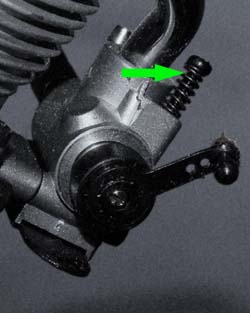
The Taming of the Screw -- Read this...... it may help you avoid a lost or crashed model
On older engines there is a screw with a spring as you can see on the following picture of the carb on a Saito-56 engine.
Saito-56 _carb
The function of this screw is two-fold. First it holds the throttle barrel in place, second it sets a mechanical stop
for the movement of the throttle barrel . The screw is adjustable so that the position of the mechanical stop can be adjusted;
why this might be a desirable feature is a real mystery because it is usual for the servo to control the throttle travel.
More recent engines no longer use a long screw with a spring as shown for example in the two pictures below of the
carbs on Saito-82a and Saito-220 engines.
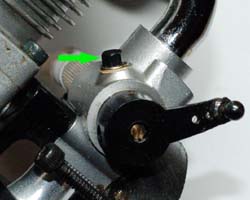
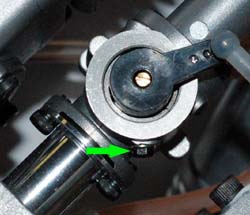
For these engines the short screw acts to hold the throttle barrel in place and there is no provision for adjustment of
the mechanical limits the mechanical movement of the throttle. The mechanical extent of the throttle movement is fixed;
this should not normally be a problem however there is a potential serious problem if you are not careful in setting up
your throttle servo. The mechanical movement is limited in such a way that when the throttle is fully open, a very small
extra movement will cause the throttle barrel to hit the preset mechanical stop; therefore it is extremely important that the throttle servo not try to push against this mechanical stop when you command full throttle from your transmitter stick.
There are two possible problems that may occur if you do not carefully set the the throttle servo throw where the servo
is inadvertantly pushing against the mechanical stop,
(1) at full throttle the servo will draw lots of extra current and rapidly drain the receiver battery or
(2) the servo gears will strip (as I have found with a certain Hitec brand servo). It is similarly important to properly set up the throttle servo throw for the idle setting; ideally when the trim is centered the engine will run at its lowest reliable idle setting, then pulling back the trim lever will cut the engine. The servo should not push the throttle barrel into its low-speed mechanical stop.
http://saito-engines.info/index.html]



